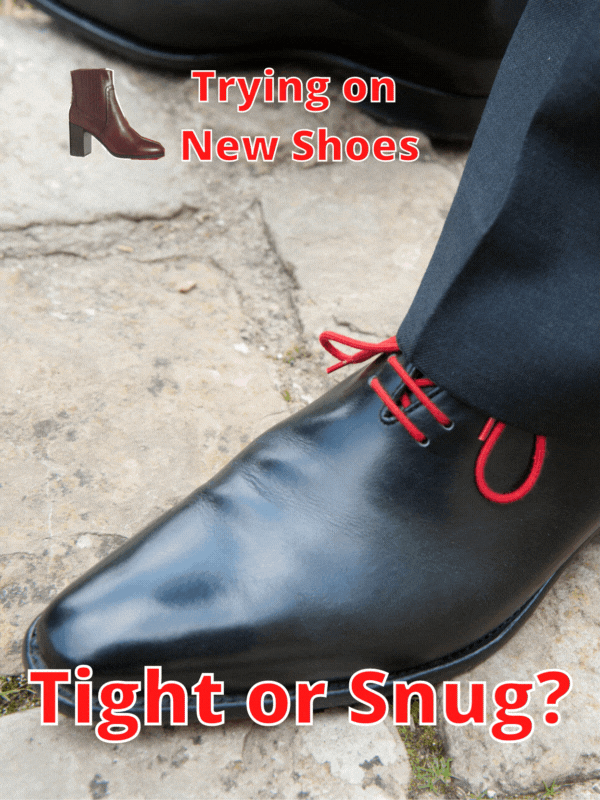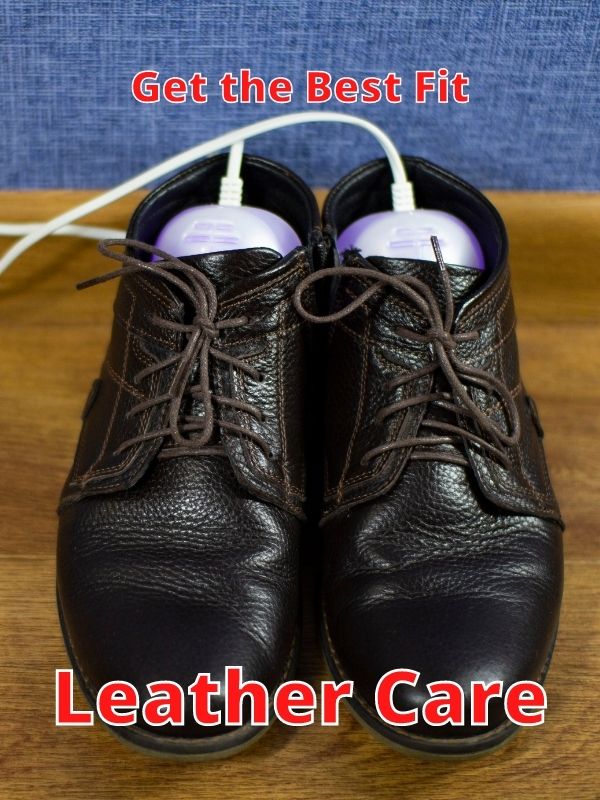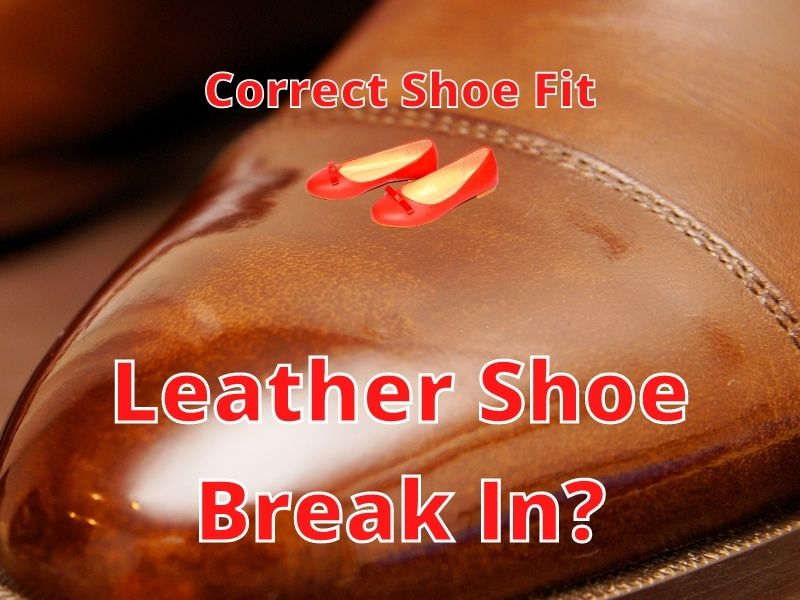I’ve had several pairs of leather shoes. Some dress shoes and some for regular everyday activities. I have had shoes that were tight and did stretch a bit, but I usually get shoes that fit well the first time I put them on.
Leather shoes should fit comfortably when you put them on. Leather can both stretch and shrink, allowing it to mold to your feet. If your leather shoes are snug (touching but not pressing) and not rubbing after 10 minutes of use then you likely have the right fit. Avoid shoes that squish feet, toes, or are too loose.
Your leather shoes will likely form a bit to your feet over time but should not be tight. By avoiding water and conditioning your leather shoes you will help them stay flexible and comfortable over time. You can take steps to ensure that they begin to be more comfortable and stay the right fit for the life of your shoe.
Table of Contents
How Tight Should Leather Shoes Be?

My Experience
When I purchased my leather shoes for work, they fit well but were a bit loose. Wear a thicker sock to help them feel snug. I was lucky they weren’t too loose or I may have had problems with rubbing.
I found that my shoes were a bit loose above my feet and near my toes, but fit snug around my heel and on the sides of my feet. This worked out well because I always felt comfortable in my shoes.
If I went running in them, which happened once in a while because I was a kindergarten teacher and played games with the children, they would stay fairly well in place most of the time.
Another time as a teen, I bought some leather sneakers, and when I tried them on, they felt tight. The salesperson and my mom told me that they would break in after a while, so I shouldn’t worry.
They actually did break in and felt fine after a while, but that got me into the wrong mindset. I would later go on to buy other shoes that were a bit tight and they didn’t break in.
Start Out With The Correct Fit
Leather shoes can be ridged or soft when you first buy them. Leather that is rigid will usually start to flex and stretch over time as you wear these shoes.
Shoes should never be tight when you feel your toes are squished or the shoe isn’t wide enough. Although leather stretches, you don’t want pressure on your feet for any long period of time. To get the right fit:
- Try on shoes until you get a snug fit. Your feet should slip into your shoe fairly easily, although many leather dress shoes require a shoehorn to get your feet in properly.
- Wear normal socks. Wear the socks you would normally wear with your leather shoes to ensure proper fit.
- Wait until they soften. Thicker leather shoes may be ridged and may feel uncomfortable even though they’re not tight. This is OK and it will usually take about a week for them to start to feel better and adjust to your feet.
- Use leather condition once you’re sure you’re keeping your shoes. Pliable soft leather shoes will feel more comfortable and shouldn’t need to be broken in but they may need a leather conditioner to remain pliable.
- Use a shoehorn each day. This helps keep your shoes looking good and shaped well for a good fit.
Avoid Sizing Issues
Shoe size can vary a lot from brand to brand, so the best option is to go to a store and try on leather shoes or buy them online from somewhere that accepts free returns. To avoid problems:
- Try it on at night. Always try shoes on in the evening when your feet are a bit more swollen or after a normal day of work.
- Buy only if there are free returns. Sometimes, a shoe just doesn’t fit even if we’ve tried it for a while. Find out what the return policy is.
- Research shoe sizing. Find out if shoes normally run small or big based on what customers are saying.
- Don’t trash them. If your shoes aren’t returnable and they don’t fit, work on ways to stretch them. They might be able to stretch with one or more methods. (See my article about ways to stretch shoes)
- Get protection. Wear moleskin, tape, badges, or other protection on your feet if your feet start to rub and get blisters or sore spots.
After sizing your shoes and avoiding unnecessary problems, your fit should feel fairly comfortable in your new leather shoes. For more ridged leather shoes, expect some discomfort for a week but not excessive rubbing or squishing of your feet.
If you find a shoe that is a bit tight, try again to find a snug one. If you still want a shoe that’s tight, it may loosen in a week, but stretching can lead to other problems. Your best bet is to find the right size from the beginning so that it will only feel snug, and then it should fit perfectly after a while.
Leather Care For Proper Fit

If you are purchasing leather shoes, they can last a long time with the proper care. Sometimes you can get a new sole placed on your older leather shoes so they will last much longer. Caring for your shoes will also help them feel comfortable for longer.
Leather needs oils to stay pliable and soft. This way, the leather can always mold around your foot and stretch a bit if needed.
If your shoes start to dry out, the leather is less flexible and not able to stretch. This might result in rubbing and discomfort. That’s why it is important to keep your leather shoes protected from excessive rain or sun. These can deplete the oils from the leather and cause cracks in your shoe.
To avoid problems with your leather shoes and how they fit, make sure to:
- Using a leather conditioner regularly. Conditioners contain oils that protect the shoe from the elements. Shoe polish and wax can also help with some protection.
- Use a shoe protection spray. Depending on the place you live and the way you use your shoes, you may also need to use a shoe protection spray to avoid problems caused by water. (See article about waterproofing shoe)
- Dry your shoes. Let moist or wet shoes dry out before you wear them. Wearing shoes that are too moist or wet can cause them to stretch. If your shoes get soaked, dry them, and once dry, use a leather conditioner to prevent shrinking.
- Use a shoetree. These shoe inserts help maintain a smooth look to your shoes and help prevent creases. Wood shoetrees (see my article about Leather Shoe Care) are good at absorbing moisture, so they can work on drying and retaining your shoe shape.
Can a Tight Shoe Still Fit?
The first thing I would check if my shoes still felt a little too tight after wearing them for a week is the label. Some shoes say they are leather but when you check more closely, they are only partially leather or faux leather (sometimes called PU leather, pleather, imitation leather, vegan leather, leatherette, and synthetic leather. (en.wikipedia.org)
It can be easy to miss if you’re not careful and the advertising is misleading or missing some information. If you happen to get faux leather then it is less likely to stretch than real leather. That’s why it will still feel uncomfortable if it was tight, to begin with. Another good reason to start out with snug shoes.
If you have real leather uppers then you can stretch your shoes using heat, ice, and shoe stretchers. (see my article about stretching leather shoe)
After you’ve stretched your shoes continue to keep them in good condition with leather conditioner and shoetrees so they will remain in their new form. Then your leather shoes will fit even if they are tight at one time.
What Happens if You Wear Tight Leather Shoes?
Depending on how soft or ridged your shoes are will determine how they will be affected. A soft, pliable leather may stretch and look fine for the most part. As the leather forms on your foot, there may be bulges on the widest part of your foot, but if it stretches enough, this might not be noticeable.
A rigid leather shoe will likely deform much more when it fits tightly. These are likely dress shoes that are supposed to have a smooth toe section that is not meant to bend. With too much pressure, these shoes will bend in the wrong places and create creases that aren’t normal for this type of shoe.
It may stretch and feel more comfortable over time but the shoe itself will not look as nice as it once did. In my opinion, it’s best not to try stretching shoes but to return the shoes before making any permanent changes to them.
Final Thoughts
When you are looking for your next pair of leather shoes, you can try on several different shoes to get a good idea of what is snug and comfortable versus tight. Aim to get snug, comfortable shoes, even if you like a pair that is tight. The best shoes will fit well the first time you put them on.
Then, you’ll have a pair of shoes that can last for many years to come with proper shoe care. Remember, the key to maintaining leather is to avoid weathering and regularly condition shoes about every two months.
Thanks for visiting Helpshoe.com

